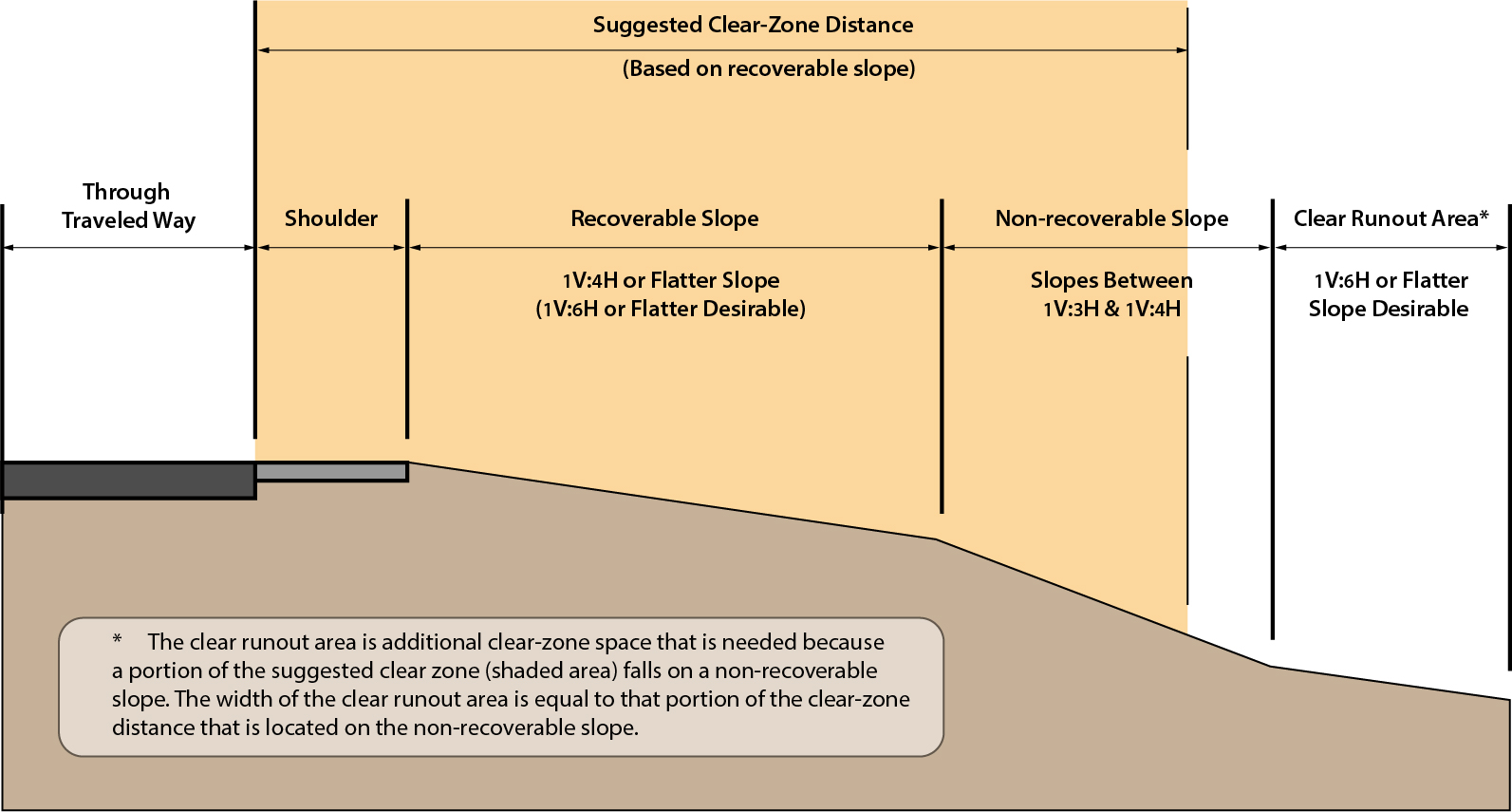Search for articles or browse our knowledge portal by topic.
Clear Zone Applications
Clear zone guidelines are most applicable for new construction. On other project types, project context and the existing roadside’s safety performance should be considered when applying clear zone concepts. Although the clear zone is not a controlling design criterion, it should be considered during highway project development and is documented in the Design Executive Summary (DES) with other engineering decisions related to the project.
Traversable, non-recoverable foreslopes with grades from 3:1 up to 4:1 should have a clear runout area beyond the toe of the foreslope. The width of a non-recoverable foreslope is not included in the clear zone distance. To give errant vehicles a chance to recover, the width of the recovery area should be the clear runout area needed to complete the clear zone distance or encompass an area at least 10 ft wide with slope of 6:1 or flatter (if practical).
Figure 2-1: Clear Zone for Non-Recoverable Parallel Foreslope

Source: RDG Figure 3-2
Bear the following considerations in mind when establishing clear zone distances for variable slopes:
- Foreslopes ranging from flat to 4:1 may be averaged to determine a composite clear zone distance using Table 2-1 in the Clear Zone – Overview article.
- Although a weighted average of foreslopes steeper than 4:1 may be used, it is preferable to use values in Table 2-1 in the Clear Zone – Overview article associated with the steeper slope.
- Slopes that transition from a foreslope to a backslope within the clear zone cannot be averaged. They should be treated as drainage channels and analyzed using Figures 3-3 and 3-4 in the Clear Zone – Overview article.
- If the foreslope between the roadway and the base of the backslope is traversable (1V:3H or flatter) and the backslope is obstacle-free, it may not be a significant obstacle, regardless of distance from the roadway. On the other hand, a steep, rough rock cut normally should begin outside the clear zone or be shielded. Typically, a rock cut is treated as rough-sided when the face will cause excessive vehicle snagging rather than provide relatively smooth redirection.
Figure 2-2: Rock Cut Example with Smooth Redirection

If an auxiliary lane does not function as a through lane (e.g., speed-change lanes on freeways), a separate clear zone is unnecessary. However, if an auxiliary lane operates as a through lane, the clear zone distance should be the larger of the following:
- The clear zone of the traveled way (mainline), using the traffic volumes, design speed and horizontal curvature of the traveled way. In this case, auxiliary lane width is included in the clear zone distance.
- The clear zone of the adjacent auxiliary lane(s) using traffic volumes, design speed, and horizontal curvature of the auxiliary lane(s). For speed change lanes, the design speed should be determined using the speed reached (Va) as derived from minimum acceleration and deceleration lane lengths (see Tables 10-4 and 10-6 of AASHTO’s A Policy on Geometric Design for Highways and Streets).
Figure 3-1: Clear Zone for Auxiliary Lane

For ramps, the suggested clear zone distance is based on the ramp’s speed, traffic volumes, horizontal curvature, and roadside geometry. The design speed should be determined from the ramp design and is typically 0.7 times the mainline design speed. When compound and reverse curves are used, the clear zone distance recommended for the higher speed curve (excluding transition curves) may be used for the entire ramp. For complex ramps with multiple radii and variable operating speeds, a separate clear zone distance may be determined for each unique ramp segment. Alternately, ramp clear zones may be set at 30 ft if the performance of similar projects or designs has been satisfactory.
- HD-800 Roadside Design
AASHTO. Roadside Design Guide, Fourth Edition, RSDG-4. American Association of State Highway and Transportation Officials, Washington, DC, 2011.
AASHTO. Guidelines for Geometric Design of Low-Volume Roads, Second Edition. American Association of State Highway and Transportation Officials, Washington, DC, 2019.
Roadside Safety Clear Zone Concepts Knowledge Book:
Access the complete Knowledge Book here: Roadside Safety Knowledge Book (coming soon) and Clear Zone Concepts Knowledge Book
Next Article: Clear Zone and Roadside Drainage Features
Previous Article: Clear Zone Overview

